In the 1970s, men's jeans exploded with personality, showcasing flared and bell-bottom styles that symbolized rebellion and self-expression. You'll find high-waisted fits paired beautifully with fitted tops, often in bold colors and eye-catching patterns like paisley. Brands like Levi's and Wrangler led the charge, introducing jeans that were not just durable but fashionable. The incorporation of unique details—embroidery, patches, and distressed looks—allowed you to express individuality. As denim evolved from workwear to cultural icon, it mirrored the vibrancy of disco and counterculture movements. Explore further to uncover the lasting impact of 1970s denim on today's fashion landscape.
Overview of 1970s Men's Jeans
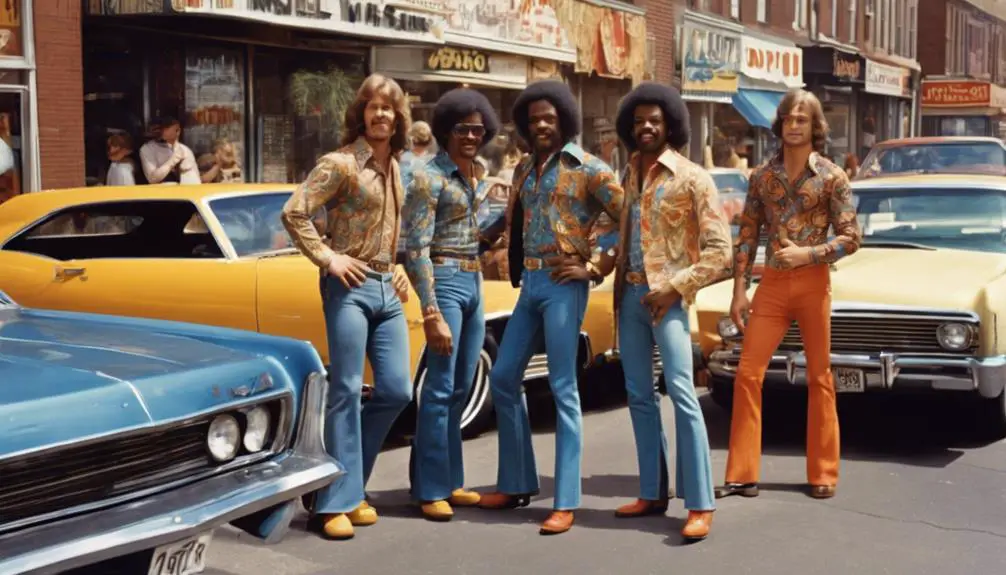
The 1970s were a transformative decade for men's jeans, marked by the rise of flared and bell-bottom styles that became synonymous with the era's vibrant fashion landscape. During this time, denim jeans evolved considerably, reflecting both cultural shifts and personal expressions. Remarkably, understanding the historical context of brands is essential for identifying genuine vintage pieces, as certain labels from this period are highly sought after by collectors. You'd notice that mens bell bottom styles prominently featured high waists, emphasizing a relaxed silhouette that aligned perfectly with the disco culture and counterculture movements.
Brands like Levi's and Wrangler led the charge, introducing various fits that catered to comfort while incorporating bold colors and unique patterns. Vintage bell styles often showcased decorative elements such as patches, embroidery, and colorful stitching, making each pair a canvas for self-expression. As the decade progressed, the emergence of designer denim raised the stakes, leading to higher prices and a focus on quality craftsmanship. This shift not only appealed to fashion-forward individuals but also created a new market for collectors seeking authentic 1970s pieces, including unique labels and construction techniques vintage clothing labels. Consequently, the jeans of this era weren't just garments; they represented a lifestyle and a statement, laying the groundwork for future denim trends.
Popular Styles and Trends
Throughout the 1970s, bell-bottom jeans emerged as a defining staple in men's fashion, capturing the spirit of the era with their distinctive wide-leg openings. These jeans weren't just about comfort; they symbolized a cultural shift towards individuality and self-expression. Flare jeans, closely associated with the disco scene, became a popular choice for both casual outings and nightlife, often paired with platform shoes to enhance their dramatic silhouette.
High-waisted styles gained traction, offering a flattering fit that complemented the body's shape. You'd typically see these styles matched with fitted tops, creating a balanced look that was both stylish and functional. As the decade progressed, denim also took on a vibrant personality, with bold colors and patterns, including paisley and floral designs, reflecting the eclectic aesthetic of 1970s fashion.
Unique details further distinguished men's jeans, with patchwork, distressed looks, and decorative stitching becoming popular features. These additions allowed wearers to showcase their unique style, making each pair of jeans a personal statement. The blend of comfort, style, and creativity in men's jeans during this era truly set the tone for future fashion movements.
Iconic Brands of the Era
In the vibrant landscape of 1970s fashion, iconic brands like Levi's, Wrangler, and Lee Jeans emerged as key players, each leaving a distinct mark on men's denim. Levi's, with its legendary 501 jeans, became synonymous with the bell-bottom trend, capturing the essence of the decade. The brand's ability to blend classic styles with contemporary flair positioned it at the forefront of the denim revolution.
Wrangler, known for its durability and western-inspired aesthetics, appealed not only to cowboys but also to urban youth searching for rugged yet stylish options. This dual appeal showcased its versatility and cemented its status as a staple in men's wardrobes.
Lee Jeans made significant strides with its relaxed fit and innovative designs, introducing the "Riders" line tailored for women, which also influenced men's fashion. Meanwhile, brands like Sasson emerged, offering tight-fitting, high-rise jeans that tapped into the disco culture, emphasizing self-expression through style.
Specialty brands like Jordache carved out a niche by focusing on fashion-forward designs and savvy marketing strategies aimed at young consumers. Together, these brands defined the denim landscape of the 1970s, each contributing to a rich tapestry of style and identity.
Cultural Influence on Denim
Denim's evolution during the 1970s wasn't just about fabric; it became a powerful cultural symbol that resonated with the rebellious spirit of the era. As you walked through the streets, you'd see bell-bottoms and flared jeans worn by the youth, reflecting their desire for freedom and self-expression. Brands like Levi Strauss seized this cultural shift, creating jeans that not only fit but also expressed individuality through vibrant colors and unique patterns.
The influence of iconic musicians and movie stars further propelled denim into the spotlight. These cultural figures embraced jeans as a staple of their image, making them synonymous with rock 'n' roll and the burgeoning film scene. Denim transformed from mere workwear to a fashion essential, with styles that catered to both comfort and creativity, including patchwork and distressed designs.
The decade's cultural currents, such as the disco movement and the hippie ethos, encouraged versatile uses of denim, allowing it to resonate across various social groups. This period solidified jeans as not just clothing but a timeless emblem of cultural identity and rebellion, forever changing the landscape of fashion.
Fabric and Design Innovations
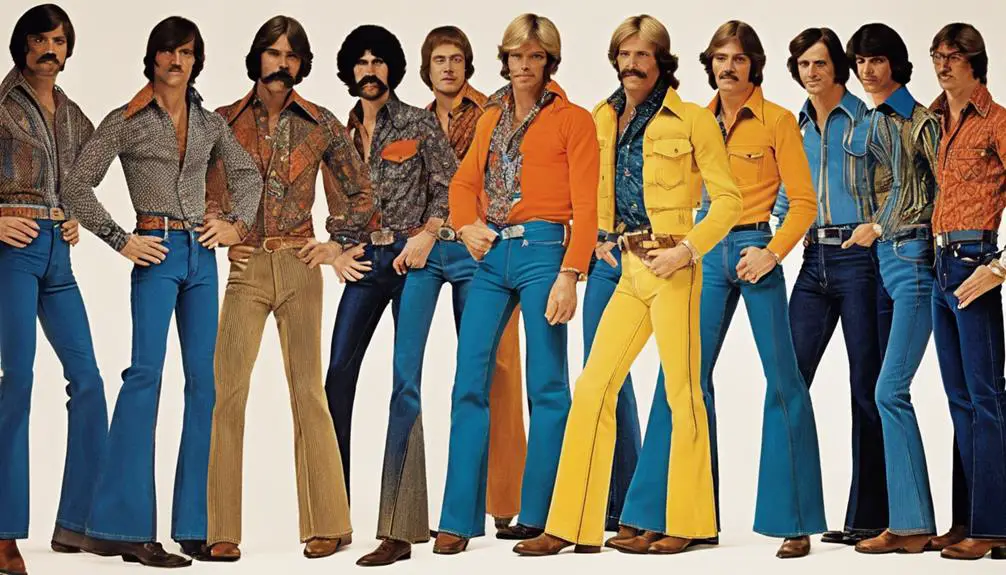
How did the 1970s redefine the essence of denim through innovative fabric and design? This decade marked a significant evolution in denim, showcasing pre-shrunk fabrics that enhanced durability and minimized post-wash shrinkage. One of the standout innovations was denim mixed with polyester, offering wearers both comfort and style without sacrificing the classic denim look.
Designers took risks, experimenting with various washes and treatments, leading to the rise of distressed and faded jeans that captured the era's rebellious spirit. The trend of patchwork and embroidery also flourished, showcasing individual expression and creativity.
Among the standout styles, Bell Bottom Pants and Corduroy Bell Bottom Pants emerged as iconic silhouettes, characterized by their wide leg openings and heavier-weight denim that added flair to any outfit.
| Innovation Type | Example Styles | Key Features |
|---|---|---|
| Fabric Blends | Denim mixed with polyester | Added stretch and comfort |
| Wash Techniques | Distressed and faded jeans | Rebellious, vintage aesthetic |
| Design Elements | Patchwork, embroidery | Personalized and creative styles |
| Popular Cuts | Bell Bottom Pants | Signature wide leg silhouette |
| Alternative Fabrics | Corduroy Bell Bottom Pants | Unique texture and warmth |
Pricing Trends in Vintage Jeans
Vintage jeans, especially those echoing the bold styles of the 1970s, have seen a dramatic shift in pricing trends over the years. You'll notice that regular fit jeans, like the iconic bell bottom styles, typically range from $39.00 to $120.00, depending on the brand and condition. This price reflects their popularity and the nostalgic appeal they hold for collectors and fashion enthusiasts alike.
However, prices can escalate quickly for rare pieces. For instance, vintage Levi's 501 Redline Selvedge Denim often lists between $350.00 and $500.00, showcasing its high value in the vintage market. Even more exclusive, pieces like the Vintage Levi's Big E Selvedge Red Line Jeans can reach up to $1,250.00, driven by their rarity and collector demand.
When you factor in shipping costs, usually between $6.50 and $24.78, the total expenditure can add up. Therefore, understanding these pricing trends is essential for anyone looking to invest in vintage jeans. Whether you're after a classic bell bottom or a sought-after style, recognizing the nuances in pricing will help you make informed purchasing decisions.
Styling Tips for Modern Wear
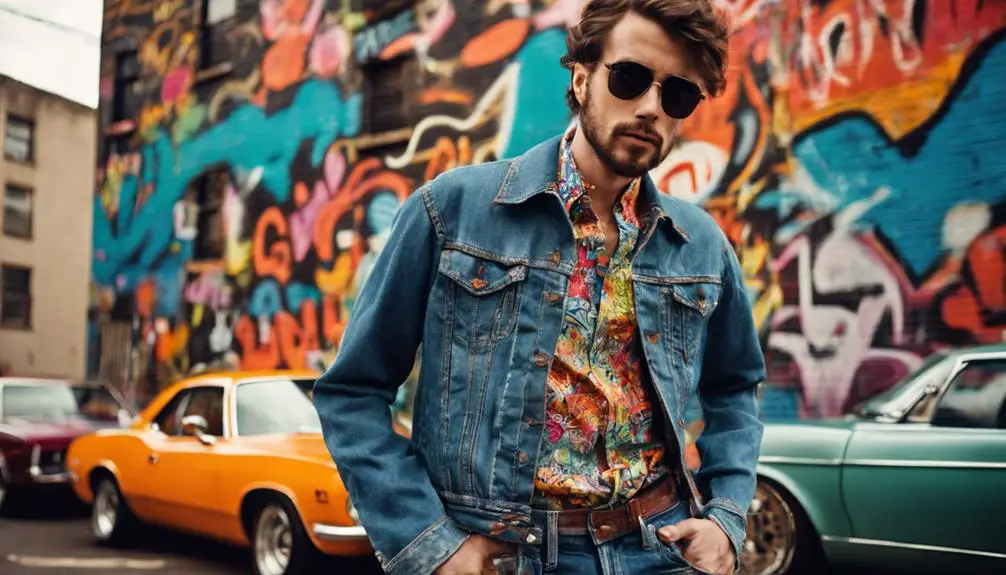
The resurgence of 1970s flared jeans in modern fashion offers a unique opportunity to blend retro aesthetics with contemporary styles. To achieve a balanced silhouette, pair your vintage bell-bottom pants with fitted tops that highlight the wide leg opening. This not only emphasizes the defining feature of the 70s style but also creates a polished look.
Footwear plays a significant role in enhancing your outfit. Opt for sneakers or platform shoes that complement the retro vibe while adding height. Accessories can further elevate your style; consider wide-brimmed hats, oversized sunglasses, and chunky jewelry to reflect the bold fashion trends of the era.
To add dimension to your outfits, layer with denim or suede jackets, which infuse a modern twist into classic 70s styles. Don't shy away from experimenting with textures and patterns; for instance, pair solid color bell-bottom pants with patterned tops or contrasting fabrics to create a unique look that stands out.
Collecting Vintage Denim Today
Collecting vintage denim today appeals to a diverse range of fashion enthusiasts and collectors, driven by nostalgia and a renewed interest in sustainable fashion. The resurgence of 1970s trends has made pieces like bell bottoms and light blue leg pants highly sought after. These styles not only evoke a sense of history but also reflect a unique aesthetic that modern consumers crave.
High-value vintage jeans, particularly iconic pairs like Levi's 501 Redline Selvedge, command impressive prices that can range from $350 to $1,250, showcasing their rarity and historical significance. Many collectors prioritize "deadstock" items—never-worn jeans that still bear original tags or packaging—because these pieces hold exceptional value and allure.
The sustainable fashion movement further fuels interest in vintage denim, as you seek unique, environmentally-friendly options that carry a story. Online marketplaces and thrift stores have become popular hunting grounds for these treasures, where authenticity and condition play vital roles in desirability. In this vibrant landscape of collectible fashion, you can find not just clothing but a connection to the past and a step toward a more sustainable future.
Frequently Asked Questions
What Jeans Did Men Wear in the 70s?
In the 70s, you'd find men wearing jeans that featured wide leg openings, high waists, and vibrant colors. Brands like Levi's and Wrangler dominated, reflecting the era's bold fashion choices and cultural influences.
What Brand Jeans Were Popular in the 70's?
In the 70s, you'd see Levi's, Wrangler, and Lee dominating the denim scene. Brands like Sasson and Jordache introduced trendy styles, reflecting cultural shifts and appealing to diverse tastes, making jeans a fashion staple.
What Were the Denim Trends in the 1970s?
In the 1970s, denim trends embraced bell-bottoms, high-waisted designs, and vibrant patterns. You'd often see unique embellishments like patches and embroidery, reflecting a desire for comfort and self-expression in your wardrobe choices during that vibrant era.
What Are 70S Jeans Called?
You'd call 70s jeans "bell-bottoms," "bootcut," or "high-waisted," reflecting the era's diverse styles. These terms capture the unique silhouettes and cultural significance, showcasing how fashion evolved to express individuality and comfort during that vibrant decade.
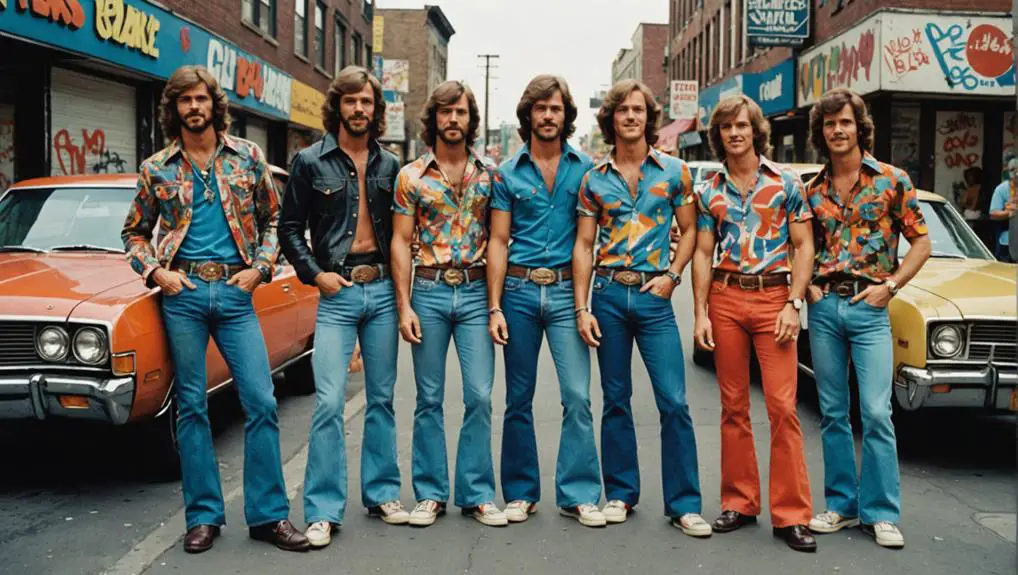

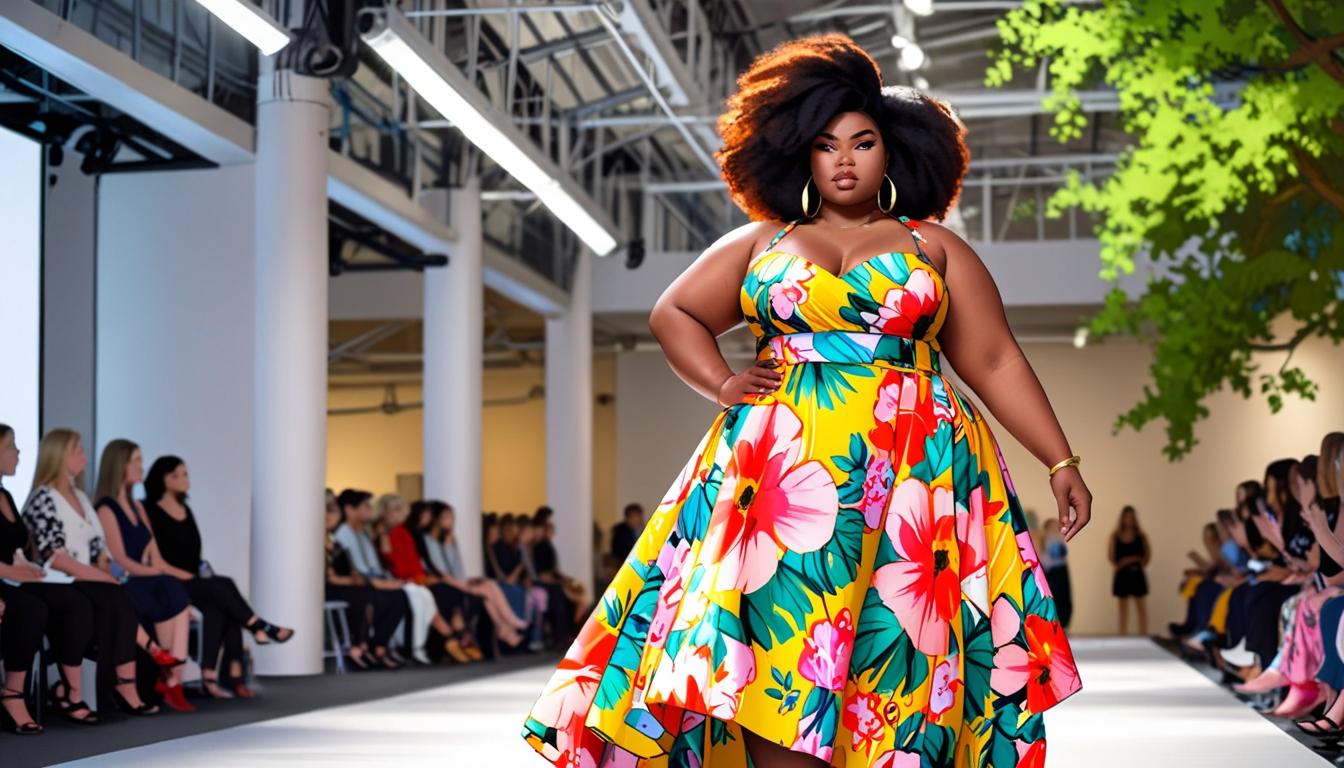

Plunge into the breathtaking galaxy of EVE Online. Become a legend today. Build alongside thousands of explorers worldwide. [url=https://www.eveonline.com/signup?invc=46758c20-63e3-4816-aa0e-f91cff26ade4]Free registration[/url]